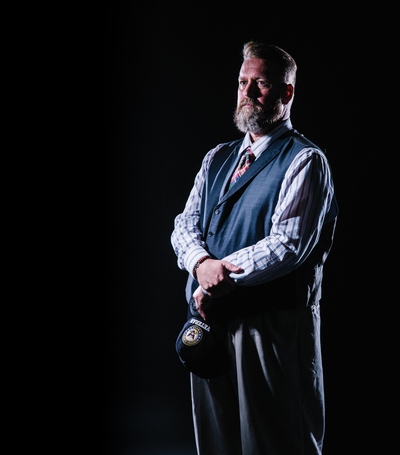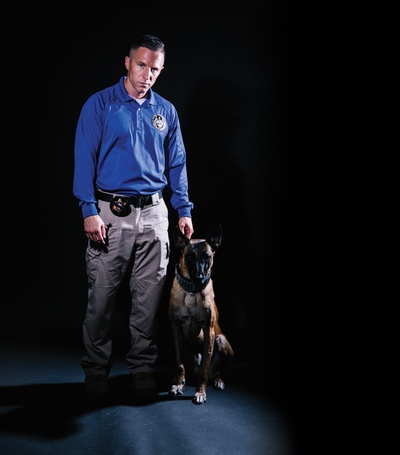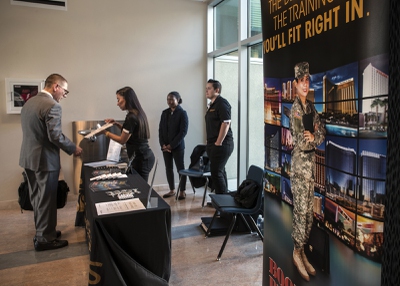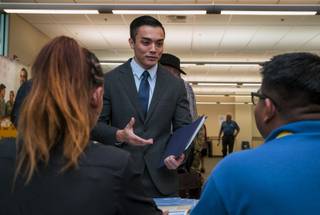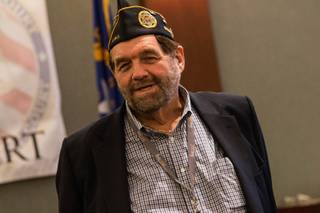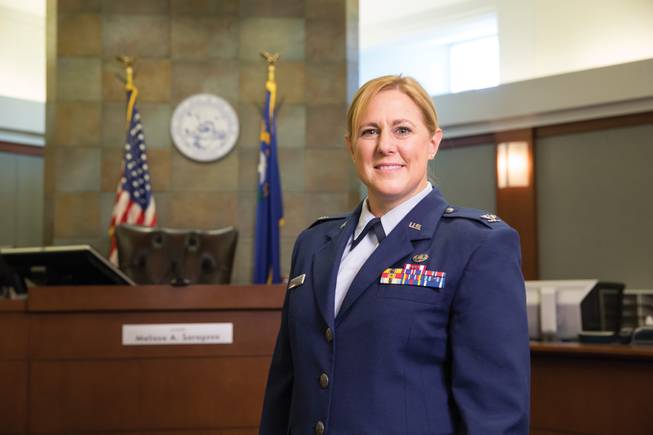
Las Vegas Justice Court Judge Melissa Saragosa is a colonel with the Air Force Reserve who oversees Veterans Treatment Court. Because of her service, she has a unique understanding of the challenges veterans face in transitioning back to the civilian world. “It’s not the same as a civilian who’s going to work and that’s their job. It really is almost your identity.”
Published Saturday, Nov. 11, 2017 | 2 a.m.
Updated Saturday, Nov. 11, 2017 | 12:31 p.m.
When Col. Lloyd Ringgold retired from the U.S. Air Force in 2013 and moved to Las Vegas to be closer to his son, he found himself starting from scratch.
Ringgold’s 26 years of continuous work experience included being chief of ground, air and weapons safety across military bases in Louisiana. An officer of his rank would be similar to a senior executive in the private sector, but after attending a casino job fair, he was offered $27,000 a year for a front-desk management position with no clear path to advancement. Working his way up and “paying dues” was one thing, but the extent to which the 52-year-old veteran was expected to start over shocked him.
Ringgold worked for a shuttle tour company for a time, then oversaw safety at a vitamin and supplement store. When it downsized, he hit the hiring fairs to network and applied for what felt like a million jobs. He thought if he could just land an in-person interview, he could explain how his skills might benefit other industries. Despite his tremendous management experience and desire to adapt, Ringgold stagnated.
His experience is common among veterans.
TOUGH TRANSITIONS
Many veterans encounter unique hurdles in transitioning back to the civilian world. Typical challenges such as culture shock, negative stereotypes and lack of understanding from prospective employers can be overshadowed by acute needs related to post-traumatic stress disorder, brain injuries or physical disabilities.
“We have to overcome the stereotypes that people get from the movies and other sources,” says Las Vegas City Councilman Steve Seroka, a former Air Force pilot who for years has advocated for veterans. “The No. 1 stereotype I hear — from government offices to presidents of nonprofit organizations, HR officials, managers — when I ask them to describe the picture in their minds when they hear the word ‘veteran’ is a homeless person under a bridge. No. 2 is somebody with PTSD who is going to hurt themselves or hurt me. No. 3 is someone who takes orders and doesn’t think.”
Seroka describes his fellow veterans as “victorious,” adding that a large majority never file a disability claim. “They want to help us. We should be welcoming them into the business and nonprofit worlds with open arms.”
But too often, employers don’t understand how to translate military experience into equivalent private-sector opportunities. When Seroka retired as an Air Force colonel in 2014, he didn’t want to move into flying for a commercial airline. He describes the transition as enrolling in “the school of hard knocks.” Eventually landing a job at the Las Vegas Metro Chamber of Commerce, Seroka engaged with elected officials and the public on behalf of the business community. In June, he successfully challenged longtime politician Bob Beers to win a seat on the Las Vegas City Council.
“None of that has anything to do with being a pilot,” Seroka says. “But that’s all skill sets required of me in the military. The challenge is understanding that every person (who serves) has so many more responsibilities than meets the eye.”
Those responsibilities being governed by a very tight structure, it can be difficult for service members to adjust to civilian work environments.
“In the military, we are our own city,” says Ronney Jacobs, who served in the Air Force for 11 years. “We can close the gates (of a base) and survive. You have everything you need. ... You get used to things running on clockwork and accountability. You don’t have a lot of delays for this and that reason. Going to civilian life, you have to have a little bit of patience.”
Jacobs is a location manager with Two Men and a Truck, a moving company with two franchises in Southern Nevada. He participated in an internal leadership program started by a former veteran.
Ringgold, too, found a new career with help from his peers. Through a veterans program, he was hired by Walmart and received management training. He is now co-manager of a local store, overseeing household products instead of aircraft equipped for war. “Most military now have degrees, enlisted or officers, and most of them are very hardworking,” Ringgold said. “Is the skill that you’re asking for something that has to be known already, or is it something that you can teach? Employers want to plug and play, (but) there’s going to be a learning curve.”
SELF-VALUATION
Michael French is the first to admit he undersold himself once he entered the civilian world.
French enlisted in the Navy in 1987, starting on a ship’s hangar bay helping park airplanes but later working with computers and networks. He left the military in 1999, a year after his wife died and left him the single father of a toddler.
He secured a job as a civilian contractor for an IT company, and they asked him what he wanted to make. Unsure of industry standards, he asked for the hourly wage he’d made in the Navy.
“I thought, ‘$18 sounds like a lot.’ They jumped at it,” said French, who later discovered the going rate was twice what he charged. “When they hired me outright, they asked what I wanted to make. (In the Navy) I was making $31,000, so I’m like, ‘$36,000?’ They said, ‘No problem!’ Found out later they were willing to pay $45,000-$50,000 depending on experience.”
And compensation questions weren’t the only challenge.
French says many IT employers required a college degree, which he didn’t have. His training had come through hands-on experience. He had certifications, which helped, but many companies wanted those in addition to a bachelor’s degree. While veterans have education opportunities via the GI Bill, going back to school wasn’t a realistic option.
“You can use the GI Bill ... Great! But if you have a family, if you have responsibilities, you still got to find work,” he said.
French has since found his niche in the financial advising industry. He frequently points younger veterans to the resources they need for life after the military, which he says isn’t just about finding employment but also about properly budgeting and saving for retirement. (Military retirement is set up differently than in the private sector.)
Like most of his peers, French is hesitant to characterize all veterans. Their backgrounds and personalities, strengths and weaknesses, interests and skills cover the spectrum. But French does note that dedication, loyalty and punctuality are drilled into service members from day one.
On paper, that should make for a model employee, but he says his experience suggests bosses also find it a little off-putting.
“A lot of employers are intimidated,” he says, recalling a time when a civilian boss questioned why he had self-selected such a short deadline for a project he was assigned. “I thought I was taking it easy!”
That culture shock can be overcome on the veteran’s side, but it can lead to issues if a boss interprets the initiative as an attempt to usurp or undermine a superior. “On the veteran side," French says, "you have to understand how to communicate with civilians.”
For 30-year-old Erik Georgi, the challenge was finding his place among them.
Following an eight-year career as a U.S. Marine that included two tours in Iraq, he landed back in Las Vegas in 2013. Georgi found work at a drywall plant, but the pay didn’t compare to what he made in the service and his new job lacked the discipline and camaraderie. When he was laid off, Georgi took a bad turn.
“I became that guy on the street that you see with the backpack and the sign (asking) for money, wondering what happened with his life,” he said. “Everything was falling apart.”
After six stints in jail last year, mostly for marijuana possession, Georgi entered rehab and Veterans Treatment Court. On a recent Wednesday, he celebrated 320 days sober — 168 in the program, which helped put him in a position to secure a car and an apartment, and to reconnect with his 10-year-old daughter.
Georgi works for his uncle at Elite Tactical Security Solutions, which employs mostly veterans. He started as a security guard and is training with a Belgian Malinois named Ike as a handler of dogs that detect explosives. “It feels really great,” he said. “I’m blown away by how amazingly my life has changed.”
He has heard of employers being nervous to hire veterans because of the potential for issues tied to physical or mental trauma. “The majority of the time that’s not really the case,” Georgi said. “You know, we’re human just like everybody else. We make mistakes, we go through hard times. ... As long as the veteran is able to adapt to the workplace community that he goes into, then everything works out pretty good.”
Having talked with fellow Marines around the country, Georgi thinks veterans resources in Las Vegas are robust — though taking advantage requires initiative and the will to overcome misconceptions. “Give us a chance just like anybody else, and let the person speak for themselves,” he says. “Don’t say, ‘He’s a veteran, so we should expect more or less out of him.’ ”
CONFRONTING STEREOTYPES
A U.S. Chamber of Commerce Foundation survey of professionals in human resources found that 49 percent believed their workplaces were free from bias against veterans and that 29 percent felt veterans were the recipients of positive biases. Only 1 percent reported a negative bias.
But ask veterans what they have experienced, and the results are markedly different. Nearly half of those surveyed said they were subjected to negative treatment.
“A lot of my coworkers think veterans are all suffering from PTSD,” says Sal Cruz, who served in the Army from 2011 to 2015. “A lot of the guys I was in service with that have done a lot more years than me didn’t have PTSD. Also, not all of us have even seen combat. It’s really strange for the majority of your coworkers to think you have something going on.”
VETERANS DAY 101
• When it is: Veterans Day occurs on Nov. 11. This differentiates it from holidays like Presidents Day (the third Monday of February) and Memorial Day (the last Monday in May), whose dates change each year. In 1968, Congress passed a bill that made Veterans Day the fourth Monday in October, but in 1975 President Gerald Ford reverted it back to Nov. 11 due to the historical significance.
• Significance of the date: Nov. 11 is the anniversary of the signing of the armistice in 1918 that ended combat in World War I. Veterans Day was originally called Armistice Day, but President Dwight D. Eisenhower changed the name in 1954.
• Who is celebrated: Veterans Day honors those who have previously served in the military. Do not confuse it with Memorial Day, which honors people who died in military service, or Armed Forces Day (the third Saturday of May), which celebrates those currently in uniform.
According to the National Center for PTSD under the Department of Veterans Affairs, rates among veterans vary depending on when they served. Estimates put the incidence among Iraq War veterans at 20 percent. It’s 11 percent for veterans of the war in Afghanistan and 10 percent for those who served in the Gulf War/Operation Desert Storm. A third of Vietnam veterans are believed to have PTSD.
Even the highest rate falls well short of being a majority of veterans. That contrasts with 8 percent of all Americans experiencing PTSD at some point in life, whether caused by rape or molestation, harassment, abuse or exposure to violence such as mass shootings or natural disasters.
Seroka says when he is talking to the public about veterans, he stresses that the disorder is not a scarlet letter that should mark someone forever. “I ask, ‘Do you know anyone who has depression? Would you hire them if they’re being treated?’ They say, ‘Absolutely.’ Well, PTSD can be treated. Over time it diminishes.”
Many misconceptions about veterans are fueled by high-profile stories covered in the media, says Las Vegas Justice Court Judge Melissa Saragosa, a colonel with the Air Force Reserve. There’s also the weight of a widely cited statistic from the U.S. Department of Veterans Affairs. Its 2012 suicide data report found that each day, 22 veterans kill themselves, though the figure lacks context. The population cannot be distilled down into any one number.
“We want people to be aware of the high veteran suicide rate, but then you can’t help but to have the other side,” Saragosa said of the way it can color the perception of all veterans. “You have a statistic that’s kind of a double-edged sword.”
The consensus among military historians and analysts is that the general public’s relationship with the military shifted after the Vietnam War. It was an unpopular conflict, and the draft ended in its wake. That resulted in a smaller percentage of the population serving and less class diversity in the armed forces. In 1971, veterans made up 72 percent of U.S. representatives and 78 percent of senators. In 2014, those figures had dropped to approximately 20 percent.
Today, less than half of 1 percent of Americans are actively in uniform. At the height of World War II, it was about 9 percent.
“And that’s not counting the people who supported the war effort,” says Seroka, referencing rationing, the push to buy wartime bonds and other tangible effects that rippled throughout the country during that time. “We have been a military at war for 26 years of continuous combat, but not a nation at war.”
Many people feel removed from or opposed to conflicts the U.S. military is engaged in overseas. Public disapproval can deepen the alienation and struggles of returning soldiers, demonstrated in the wake of the Vietnam War and accounting for the outsize incidence of PTSD among those soldiers.
When Edward Smith left the Navy after the end of that war, he felt like few career options existed.
“When we came back, we needed to survive the next hurdle, and the next hurdle, and the next hurdle,” he recalls. “Those things I guess come from an individual, as well as what (they) come home to. You need to come home to a thriving country where everything is working for you, where you can get a job, or you can be something.”
While conditions have improved for veterans in many respects since that era, Smith says he still struggles to find value in, or results from, many of the veterans programs offered today. He sees endless room for improvement and wishes a more holistic approach were taken. “You have to embrace that whole person ...”
EMPLOYMENT PICTURE
Veterans may face hurdles wherever they settle after taking off the uniform, but some see Southern Nevada as especially challenging because the economy is dominated by tourism. According to the U.S. Bureau of Labor Statistics, only 3.6 percent of veterans nationwide work in leisure and hospitality, compared with 8.5 percent of nonveterans.
“It’s the least likely for a vet to get into,” Seroka says.
Some industry players are trying to counter this with specific initiatives catered to veterans and their families. The Cosmopolitan, for example, hosts mixers and actively recruits veterans, and the resort reported this spring that 200 of its 5,000 employees are former military or spouses.
But the employment needs of veterans dovetail with Nevada’s larger goal of economic diversification, as it could smooth the path to finding comparable, better-paying jobs after service. Among the key industries identified by the Las Vegas Greater Economic Alliance for growth are aerospace, technology, manufacturing and logistics — all with clear parallels to the military.
At a recent event at the Amazon fulfillment center in North Las Vegas, Nevada Sen. David Parks, who served in the Air Force, praised the mega-employer for its ongoing efforts to hire veterans. They represent 60 of the center’s 2,000 employees.
Nationwide, Amazon has hired 10,000 veterans and is aiming for many thousands more in the next five years. The company is in the process of choosing a new location for a second headquarters, and Southern Nevada submitted a proposal.
NEW PROGRAMS
The military is working on better preparing service members for life as veterans. Mandatory transition classes have gotten longer and cover more topics, ranging from pre-separation counseling to a demo on translating military skills to an entrepreneurship track called Boots to Business. Meanwhile, more initiatives focused on workforce development exist than ever before.
One is a corporate fellowship organized by Hiring Our Heroes, a program of the U.S. Chamber of Commerce. It places transitioning active-duty service members who have at least a bachelor’s degree in 12-week fellowships that match their skill sets. Members of the cohort get experience four days a week within the civilian sector while getting paid by the military. Every Friday, they meet to talk about the transition and learn other skills that could aid professional advancement.
Twelve military bases, including Nellis Air Force Base, offer the innovative training.
“There is no other program like this,” says Marady Leary, who directs it at Nellis. “Others are focused on what happens once they get out. This is catering to people pre-transition. We wanted to get ahead of the curve, before they get out, so they aren’t signing up for unemployment. We’ve found that if we get them into companies and show off their skills, (employers) are much more likely to hire them.”
The national placement rate of fellows into full-time jobs with these companies is 86 percent. Nine are participating in Southern Nevada: Aristocrat Technology, Caesars Entertainment, Amazon, Aramark, UPS, Healthcare Services Group, First Command, the Veterans Administration and the city of Las Vegas. And Leary is actively recruiting.
Broader programs focused on veterans have gotten savvier about the specific needs of those looking for work. Work for Warriors Nevada, another that is federally funded, has employment specialists connecting veterans to existing partners or helping prepare them for their own job searches. Translating military ranks, titles and responsibilities into language human resources departments will understand is a big part of that. For those hoping to get into new career fields, using a skills-based resumé instead of a chronological one can make the difference.
“Every person is different,” says Nichole Nguyen, an employment coordinator with Work for Warriors. “The first thing we do is sit down with them for maybe two, three hours. We figure out the best way to help them with their needs. Then, we help them along the entire way.”
Other federally funded programs take business executives on tours of military bases in order to show them firsthand the spectrum of tasks, skills and people. The idea is that a real-life connection breaks through stereotypes to reveal the potential.
“We need to bridge the gap,” Nguyen says. “It shouldn’t be this hard to find a second career. They’ve sacrificed so much already.”
BOUNCING BACK
It is in the midst of these struggles that veterans can lose their way, falling into destructive behaviors that fit some of the stereotypes.
“I think (joblessness) definitely has a toll on someone’s ability to cope with everyday stresses and financial burdens, and anxiety and depression. And when this happens, I think it’s not uncommon to try to wash that away with drugs or alcohol,” Saragosa says. It might not make the difference for those suffering from severe PTSD, she says, but employment is “critical” to others avoiding downward spirals and successfully transitioning.
The Veterans Treatment Court, which Saragosa heads, was established by the Nevada Legislature in 2009 to reduce re-arrests of veterans and military personnel who land in the legal system on misdemeanor charges. The one-year program helps those who suffer from mental illness, PTSD, or alcohol or drug abuse, or who have other problems related to their service or readjustment into civilian life. It offers treatment and structure.
In his Oct. 25 graduation speech, Navy veteran Nathan Sexton tearfully thanked Saragosa, his family and the program. “I’m a recovering heroin addict. I couldn’t get it together no matter what I did, and this program saved my life in so many ways.”
While in the program, Sexton continued to make mistakes and was almost dismissed. “I got an opportunity and I knew it was my last one, and I knew I had to turn things around. Not just for the court, but for myself,” he said.
That Wednesday, Sexton was celebrating 261 days sober, employment at a restaurant, an independent living situation, reconnection with family and a plan for his future. In the audience were veterans' family members and advocates, as well as representatives from Nevada's congressional delegation.
“The easy way is to take a few weeks in jail," Saragosa said, "but doing this program and bettering life — that is the hard way.”
Similar to military promotions, the yearlong treatment program has four phases that allow the veterans to "rank up." Nevada Supreme Court Justice Michael Cherry, the ceremony's keynote speaker, donned his Air Force hat before addressing those graduating or moving to the next phase.
After detailing his military career and service as a public defender, Cherry shared that he'd gone through his own struggles with alcohol and drugs. In 1986, he said, “I put a lid on everything that was bad. And if you think about a drink or taking a drug or you want to commit a crime, think about the chief justice wearing that funny hat and telling you about his 31 years of success being in recovery."
Pointing at each veteran, Cherry said: "If I can make it and do what I do, then you can make it.”
EMPLOYMENT RESOURCES FOR VETERANS
• Nevada Department of Veterans Services: 702-791-9000 ext. 15518, click here
• Las Vegas Justice Court Veterans Treatment Court: 702-671-3317, click here
• U.S. Department of Veterans Affairs – Las Vegas: click here
• Work For Warriors Nevada: 702-632-0551, click here
• Hiring Our Heroes: 202-463-5500, click here; email here
• Feds Hire Vets: 202-606-7304, click here

